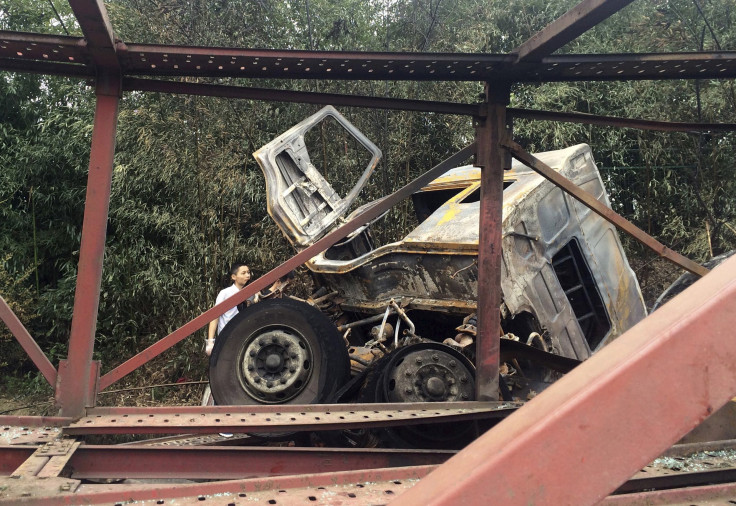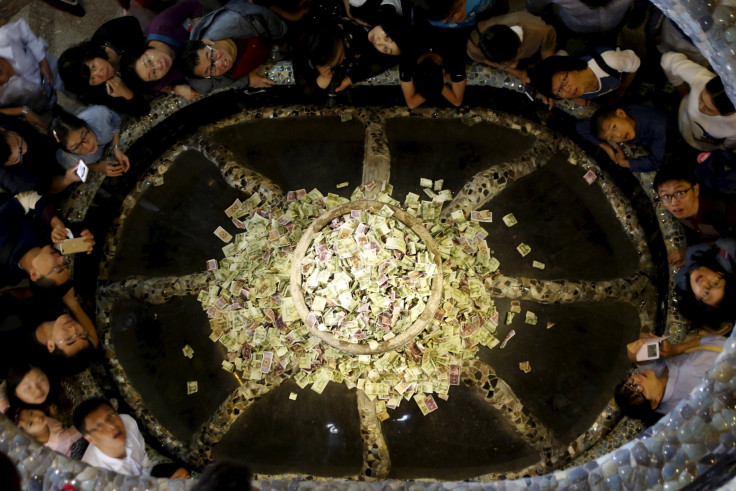China 'Golden Week' Travel: Record Numbers Brave Crowds, Gridlock, And Punishment For Bad Behavior

SHANGHAI -- Vast crowds, gridlock on roads and punishment for bad behavior at scenic spots could not prevent record numbers of Chinese tourists from travelling during the country’s seven-day National Day vacation, which ends Wednesday.
An estimated 750 million people, more than half of China’s population, took trips, state media said -- with train journeys hitting a record 12.5 million on the first day, and around 100 million predicted for the holiday period, up 10 percent up on the previous year.
The National Day ‘Golden Week,’ as it’s known, comes at a timely moment, providing a much needed boost for China’s slowing economy, which has been hit by falling exports and a slump in the country’s stock market. It’s also China’s peak season for domestic tourism, since the country’s other weeklong holiday, at Chinese New Year, falls during the cold winter months, and many people spend that break at home with relatives. And while some tourists told local media they were reining in spending this year, economists said the holiday crowds were evidence of continuing growth in China’s domestic consumption, which has been one of the economy’s few bright spots.

Many of China’s middle class, however, now choose to spend their money abroad: travel agencies showed record numbers of tourists visiting neighboring countries like Japan, which is popular with Chinese travelers for the quality of its goods and food, and where the yen remains relatively week against China’s currency. Hotels in the popular tourist destination of Kyoto were almost fully booked last weekend, and visitors reported crowds of Chinese tourists dressed in traditional Japanese kimonos wandering the city’s narrow streets. (There were reports of a decline in the number of Chinese shoppers visiting Hong Kong, following anti-mainland political protests in the city over the past year.)
As is now customary during vacations, toll fees on China’s highways were waived for the holiday period, contributing to gridlock on roads out of major cities and to tourist sites at the start of the holiday. Chinese officials said part of the problem was that, despite a slowdown in the country’s booming auto market this year, 17 million more cars have hit the country’s roads since January. More than 650 million road journeys were expected to be made in China over the holiday week.
To cope with the crowds, many tourist destinations introduced caps on numbers: the popular panda sanctuary and nature reserve at Jiuzhaigou in Sichuan limited visitors to around 40,000 per day, while the Forbidden City in Beijing restricted entries to 80,000 a day (of which more than half had to be booked in advance). More than 400 extra public toilets were installed in nearby Tiananmen Square to cater to the crowds.

Security was also stepped up in China’s financial capital Shanghai, after the city experienced one of its worst ever disasters, a stampede that left 36 people dead, on its famous Bund waterfront during celebrations of the new year last December. The city government introduced a new social media app showing visitors the flow of tourists in different parts of the city, in an attempt to avoid overcrowding.
Yet some areas still drew huge crowds. The popular lakeside city of Hangzhou, west of Shanghai, attracted more than 1.5 million visitors on Chinese National Day, Oct. 1, while the mausoleum of Sun Yat-sen, China’s first republican-era president, received 250,000 visitors on the second day of the holiday. Nan Luo Gu Xiang, a popular narrow lane of traditional courtyard houses in Beijing, also saw more than 100,000 visitors a day, according to the China Daily.
And official precautions could not prevent a number of accidents. China has an average of more than 500 road deaths a day, and while police reported that there had been “no traffic accidents involving more than five deaths” on the first day of the holiday, more serious accidents did occur: seven people were reported to have died and more than 30 were injured when a tourist bus fell off a bridge in Anhui province Monday.

Crowds also panicked when a crack appeared in a new glass-bottomed tourist walkway on a mountain in Henan province, local media reported. The crack was reportedly caused by a tourist dropping a flask of tea on the walkway, officials said, though no-one was hurt.
And with China having introduced new rules -- including an official blacklist -- to curb bad behavior by tourists following repeated complaints about the behavior of some Chinese travelers both at home and abroad, several areas stepped up controls. The Forbidden City in Beijing announced a real-name ticket booking system, with anyone who infringed rules facing a ban from the site. And in Hangzhou, four tourists who took photographs sitting on the heads of statues of “martyred firemen” were detained by police overnight following public criticism online, and were later photographed bowing in apology to the statues.
News website The Paper, meanwhile, reported that tourists at an ancient city in northwestern Gansu province ignored signs telling them to keep off ruins, saying they had "survived thousands of years so they weren't likely to collapse now."
Some people simply avoided the crowds by deciding not to travel -- one reason why China’s movie box office continued the spectacular performance that has seen it grow by 50 percent year-on-year, making it the world’s second largest. And while fewer mainland shoppers were seen in Hong Kong this year, the top-grossing movie in China over the holiday week was "Lost in Hong Kong", a sequel to the 2012 breakout Chinese comedy "Lost in Thailand," about hapless Chinese tourists. It took more than $200 million in its first 10 days.

Some of those who did travel apparently felt similarly lost: Liu Jun, a retired Shanghai worker in his early 60s, told International Business Times that he had spent a week on a group tour of Southeast Asia, his first trip abroad -- but had found the food and language a problem, had been taken to over-priced tourist stores and been duped by convenience store assistants who he complained didn’t give change to Chinese tourists.
Meanwhile, the China National Tourism Administration is reported to have proposed a plan to stagger public holidays, with different days in different parts of the country, in order to reduce the pressure on the country’s transport and tourism infrastructure in future. It said the current system created not only congestion on roads, but “a heavy burden on the environment at tourist attractions, and poor quality of experience for the tourists," according to the South China Morning Post, at a time when many Chinese travelers now expected higher standards and quality of service.
© Copyright IBTimes 2024. All rights reserved.





















